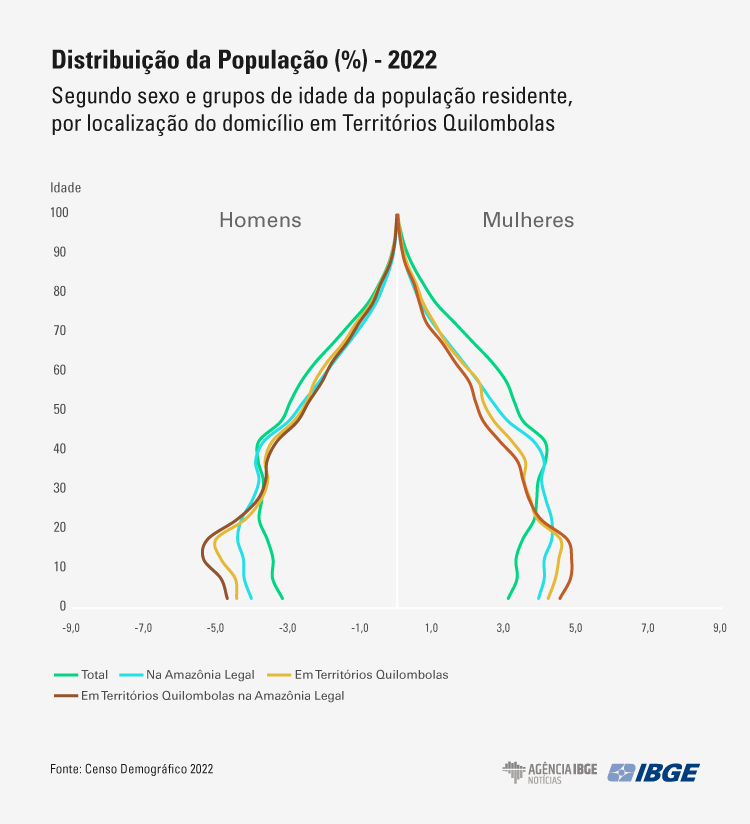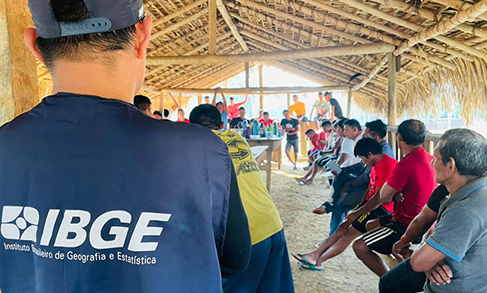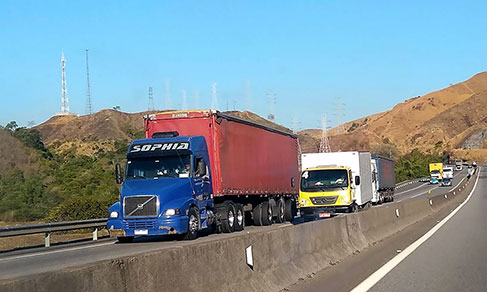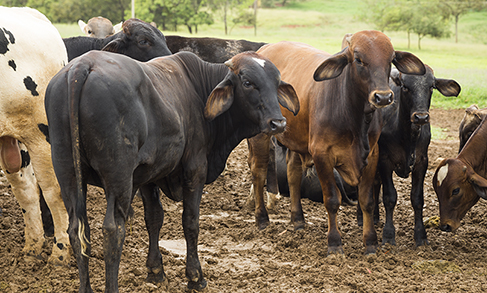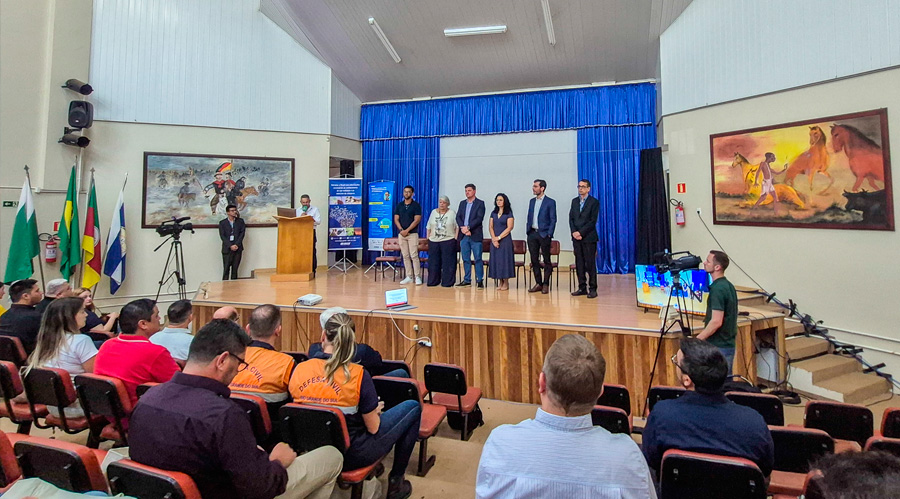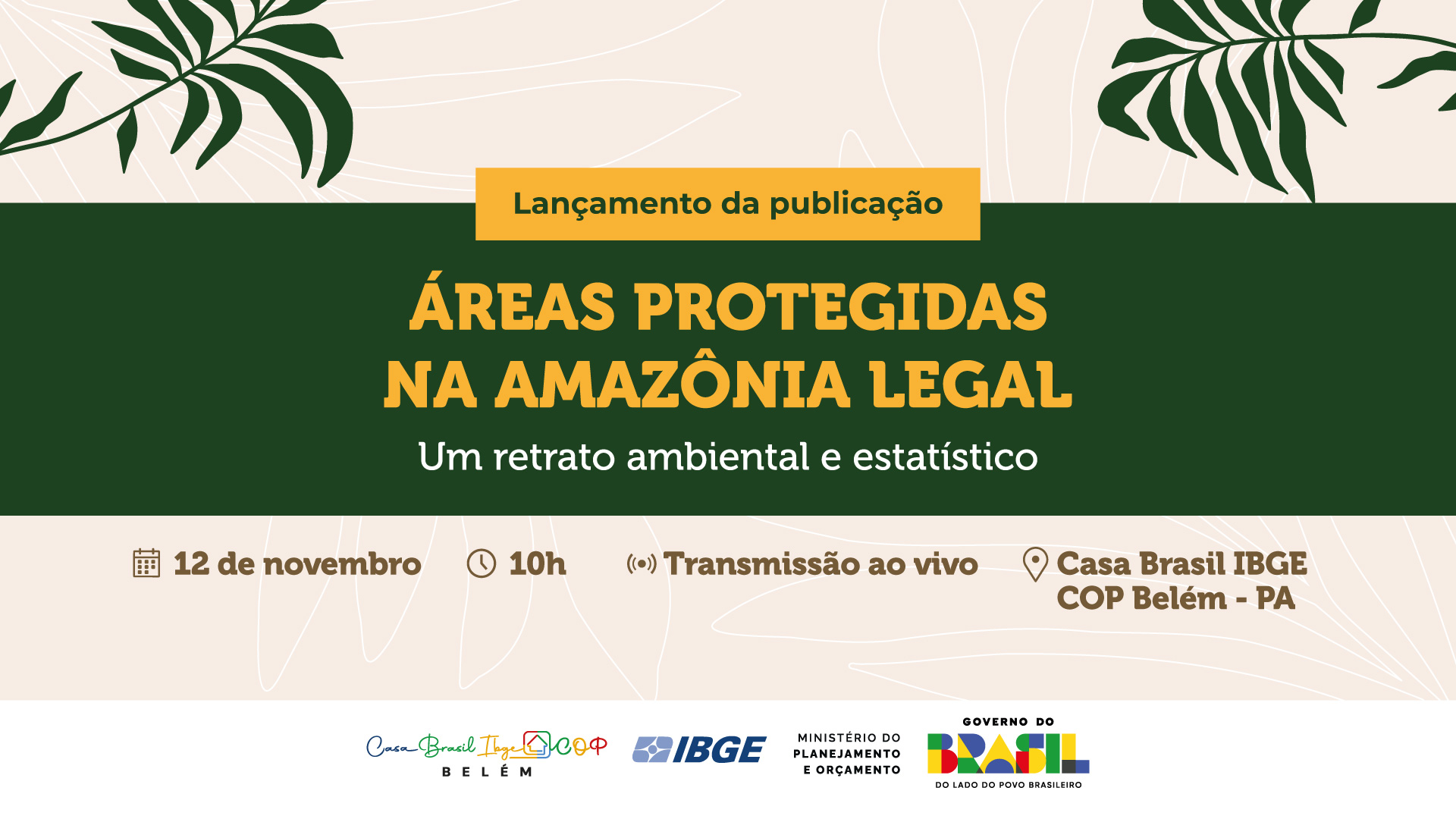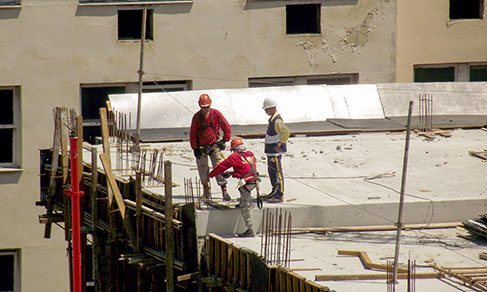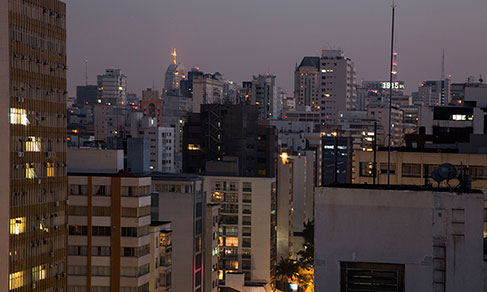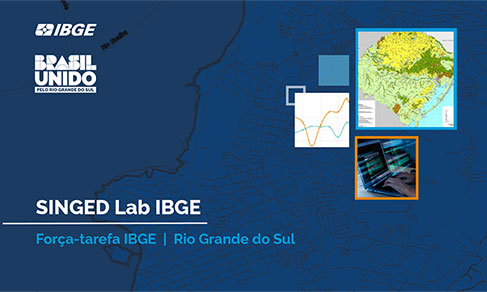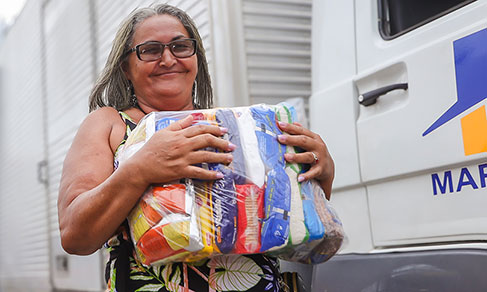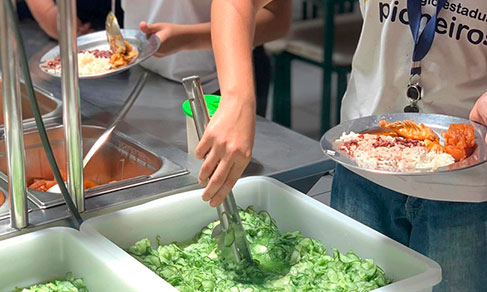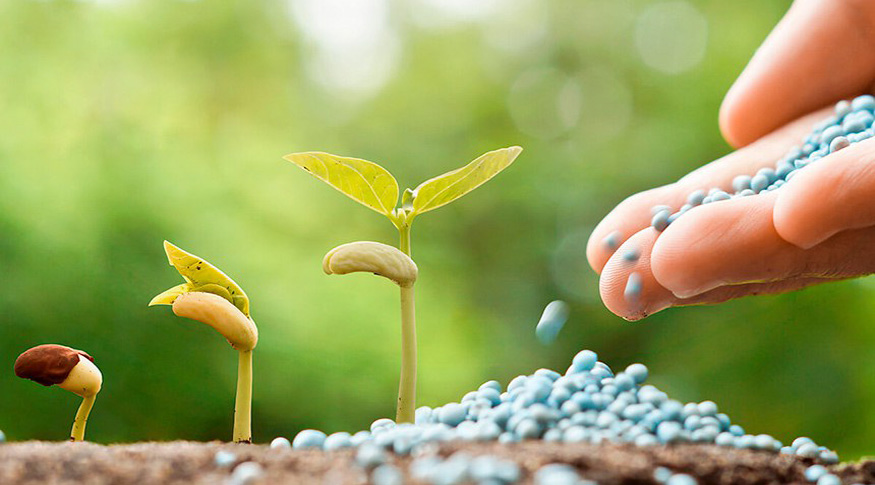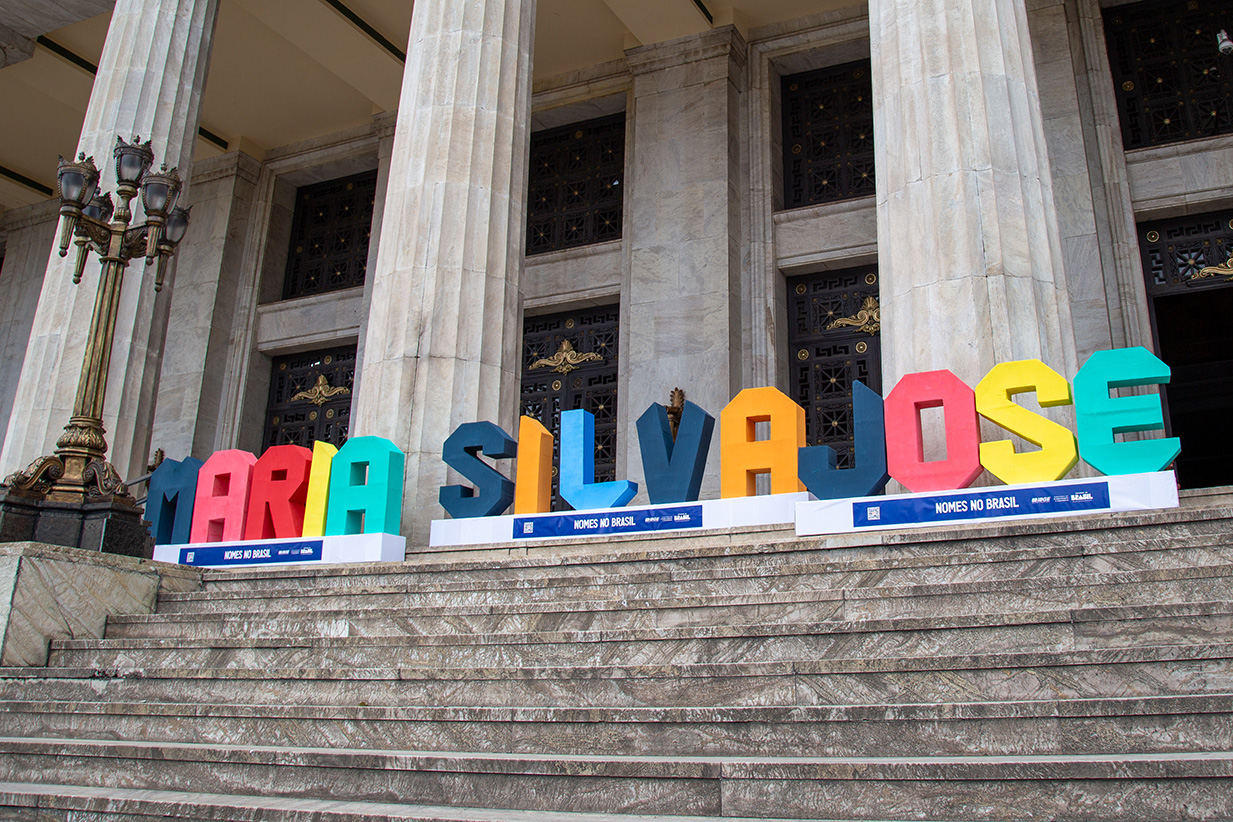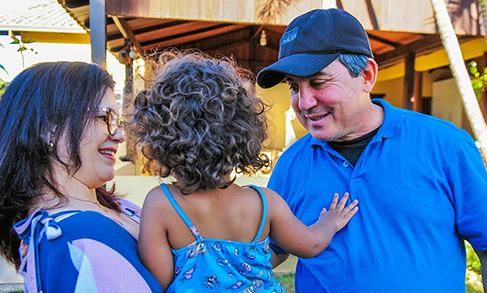Legal Amazon
IBGE makes a portrait of Conservation Areas, Indigenous Lands and Quilombola Territories in the Legal Amazon
November 12, 2025 10h00 AM | Last Updated: November 13, 2025 02h30 AM
Highlights
- The publication protected Areas in the Legal Amazon: An environmental and statistical portrait was released today (12) by the IBGE during the 30th UN Conference of the Parties on Climate Change (COP30), in Belém (PA).
- The work presents a special approach to the Legal Amazon based on data previously released by the IBGE.
- The statistical portrait covers data from the 2022 Census, which show that a significant number of residents of protected areas in the Legal Amazon have poor access to water supply, sewage disposal or waste collection services: Indigenous Lands (98.04%), Quilombola Territories (96.90%); Conservation Unis (75.19%). In the country, 27.28% of the residents faced precarious sanitation conditions to a certain extent.
- Whereas the illiteracy rate in Brazil was 7.00% in 2022, in some protected areas in the Legal Amazon the index was more than three time higher: Indigenous Lands (22.74%), Quilombola Territories (17.87%) and Conservation Areas (12.92%).
- Indigenous Lands in the Legal Amazon were inhabited by 428,105 people in 2022, with 94.29% (403,679) Indigenous persons and 5.71% non-Indigenous (24,426).
- Quilombola Territories in the Legal Amazon had 91,784 residents in 2022, with 88.51% (81,234) Quilombolas and 11.49% (10,550), non-Quilombolas.
- Conservation Areas in the Legal Amazon had 2,269,009 residents in 2022.
- The Legal Amazon gathers 84.11% of the population in the country living in Extractive Reserves, Sustainable Development Reserves and National, State or Municipal Forests, where traditional peoples and communities are expected to be found.
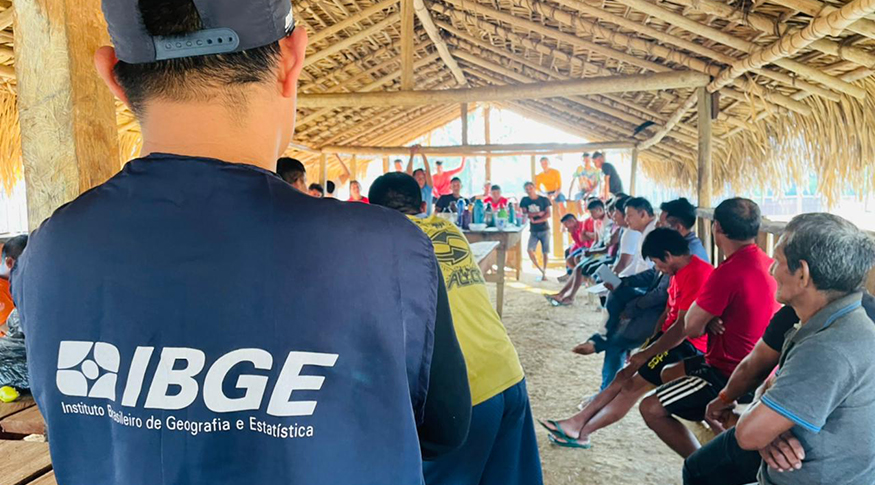
The IBGE has released today (12) the publication Protected Areas in the Legal Amazon: An environmental and statistical portrait, which shows an overview of Conservation Areas, Indigenous Lands and officially-delimited Quilombola Territories within the Legal Amazon. The work has a specific approach based on data that have already been released by the IBGE. The launch event will take place at Casa Brasil IBGE in Belém (PA), during the 30th UN Conference of the Parties on Climate Change (COP30). Watch the event live on Digital IBGE.
Information on sanitation, literacy and the profile of residents of protected areas by sex and age is included in the publication. The statistical portrait refers to data from the 2022 Population Census, whereas the environmental approach used data of 2023 taken from IBGE's Environmental Information Database (BDiA). Click here to see the complete results.
Conservation Areas, Indigenous Lands and Quilombola Territories are protected areas, but they can be overlapped in some cases, according to Marta Antunes, manager of Traditional Peoples and Communities at the IBGE. “There may be overlaps of Conservation Areas and Indigenous Lands, for example. Our calculations exclude overlaps and the area is analyzed by square kilometer, but the exclusion of overlaps for the population is a more complex step, still in progress, so the total number of residents of the protected areas cannot be added up."
Considering the total country's population, 27.28% of residents faced precarious sanitation to a certain extent, according to the parameters of the National Sanitation Plan (PLANSAB) and 3.00% faced the three forms of precarious access simultaneously. In Conservation Areas within the Legal Amazon, 75.19% of residents (1,700,202) faced precarious conditions of water supply, sewage disposal or waste colectiom. The proportion is higher that that observed among residents of Conservation Areas in the country (40.34%). When data of residents that face the three forms of precarious access to sanitation services in all the dimensions analyzed - water supply, sewage disposal and waste collection - the percentage is 22.23%, a more serios situtation than in Conservation Areas in Brazil (7.31%).
Marta explains that the analysis of precarious conditions, according to criteria of PLANSAB, considers solutions adapted to rural areas and more far-off regions, which may have additions difficulties. “The existence of a septic tank of filter, or of a piped spring or well indicates a more adequate status. Direct or indirect waste collection is more scarce in these specific areas. Somehow, these data show that investments are still not adequate or adapted to the reality of rural or far-off regions of protected areas,” remarks the manager of Traditional Peoples and Communities at the IBGE.
In the Legal Amazon, Conservation Areas have 662,401 occupied permanent private housing units, with 2,261,183 people, and an average of 3.41 residents, a figure above 2.95, which is the average of residents in Conservation Areas in the country.
| Conservation Areas, by indication of precariousness in terms of water supply, sewage disposal and waste collection, according to housing unit location in the Areas - 2022 | |||||
|---|---|---|---|---|---|
| Housing unit location | Residents of occupied permanent private housing units | ||||
| Total | Facing some form of precariousness in relation to water supply, sewage disposal or waste collection | Facing combined forms of precariousness in relation to water supply, sewage disposal and waste collection (2) | |||
| Absolute | Percentage (%) | Absolute | Percentage (%) | ||
| Total | 202,083,020 | 55,135,092 | 27.28 | 6,053,981 | 3.00 |
| In Conservation Areas | 11,714,935 | 4,725,613 | 40.34 | 856,495 | 7.31 |
| In Conservation Areas in the Legal Amazon | 2,261,183 | 1,700,202 | 75.19 | 502,772 | 22.23 |
| Legal Amazon of Rondônia (RO) | 10,333 | 9,946 | 96.25 | 1,818 | 17.59 |
| Legal Amazon of Acre (AC) | 32,059 | 29,531 | 92.11 | 17,210 | 53,68 |
| Legal Amazon of Amazonas (AM) | 261,173 | 160,278 | 61.37 | 60,996 | 23,35 |
| Legal Amazon of Roraima (RR) | 3,210 | 2,400 | 74.77 | 963 | 30,00 |
| Legal Amazon of Pará (PA) | 574,832 | 444,732 | 77,37 | 195,414 | 33,99 |
| Legal Amazon of Amapá (AP) | 11,566 | 10,289 | 88,96 | 3,075 | 26,59 |
| Legal Amazon of Tocantins (TO) | 63,450 | 45,246 | 71,31 | 2,754 | 4,34 |
| Legal Amazon of (MA) | 1,275,481 | 979,169 | 76,77 | 219,692 | 17,22 |
| Legal Amazon of Mato Grosso (MT) | 29,079 | 18,611 | 64,00 | 850 | 2,92 |
| Source: IBGE, Censo Demográfico 2022 (1) General distribution network, well, source or spring, piped or non-piped up to the property land, or systems in which, with or without plumbing, water comes from water trucks, stored rainwater, rivers, dams, streams, lakes, creeks or other forms not previously listed; or sewage systems using rudimentary pits, holes, ditches, rivers, streams, sea or others, or without sewerage (due to the lack of bathrooms or toilets); or waste neither directly or indirectly collected by a cleaning service. (2) General distribution network, well, source or spring, piped or non-piped up to the property land, and systems in which, with or without plumbing, water comes from water trucks, stored rainwater, rivers, dams, streams, lakes, creeks or other forms not previously listed; and sewage systems using rudimentary pits, holes, ditches, rivers, streams, sea or others, or without sewerage (due to the lack of bathrooms or toilets); and waste neither directly or indirectly collected by a cleaning service. |
|||||
Conservation Areas in the Legal Amazon: illiteracy rate is 12.92%
When literacy data are analyzed, the percentage of persons who can read and write at least a simple note was 87.08% in Conservation Areas in the Legal Amazon. That is, the illiteracy rate was 12.92%. In Conservation Areas in Brazil, 91.16% were literate, with an illiteracy rates of 8.84%.
The resident population of Conservation Areas in the Legal amazon is younger thtan that of Conservation Areas in Brazil. There are more men than women in the age groups below 24 years, 40 to 54 years and 60 to 74 years.
Brown persons are the majority of the population in Conservation Areas in the Legal Amazon, with 1,566,601 residents (69.04%). In second place, white persons, a total of 376,661 (16.600%); and then black persons, 284,575 (12.54%). The resident Quilombola population of Conservation Areas amounts to 186,537 (8.22%) and the Indigenous population, 50,154 (2.21%).
| Percentage of resident population of Conservation Areas in the Legal Amazon, by color or race and Indigenous and Quilombola ethnic belonging, according to Federation Units - Brazil - 2022 | |||||||
|---|---|---|---|---|---|---|---|
| Brazil, Legal Amazon and Legal Amazon of the Federation Unit | Percentage (%) | ||||||
| Color or race | Indigenous persons | Quilombola persons | |||||
| White | Black | Asian | Brown | Indigenous | |||
| Brazil | 35.82 | 11.92 | 0.30 | 51.12 | 0.84 | 1.12 | 2,39 |
| Legal Amazon | 16.60 | 12.54 | 0.09 | 69.04 | 1.72 | 2.21 | 8,22 |
| Legal Amazon of Rondônia (RO) | 23.91 | 8.22 | 0.10 | 64.95 | 2.82 | 3.92 | 1,61 |
| Legal Amazon of Acre (AC) | 14.54 | 7.04 | 0.19 | 72.58 | 5,66 | 6,16 | - |
| Legal Amazon of Amazonas (AM) | 16.48 | 4.37 | 0.16 | 69.05 | 9.94 | 13.04 | 0.08 |
| Legal Amazon of Roraima (RR) | 17.04 | 4.55 | 0.19 | 74.74 | 3.49 | 3.49 | - |
| Amazônia Legal do Pará (PA) | 15.39 | 9.40 | 0.10 | 73.80 | 1.30 | 1.64 | 2.78 |
| Legal Amazon of Amapá (AP) | 12.39 | 21.15 | 0.09 | 65.23 | 1.13 | 1.13 | 19.15 |
| Legal Amazon of Tocantins (TO) | 20.52 | 13.37 | 0.21 | 64.96 | 0.94 | 0.98 | 2.00 |
| Legal Amazon of Maranhão (MA) | 16.90 | 15.75 | 0.06 | 67.11 | 0.17 | 0.23 | 13.01 |
| Legal Amazon of Mato Grosso (MT) | 21.16 | 11.20 | 0.29 | 66.53 | 0.83 | 0.83 | 1.59 |
| Source: IBGE, Censo Demográfico 2022. Note: The data related to Indigenous persons consider the declaration of ethnic belonging based on the information provided in the question on color or race and if the person considers themselves Indigenous. |
|||||||
In Conservation Areas in the Legal Amazon, 2,062,037 (90.88%) people live in Environmental Protection Areas, the biggest proportion among all the categories. In Brazil, there are 11,466,934 residents in Environmental Protection Areas. These are followed by Extractive Reserves, which gather 104,953 residents in the Legal Amazon or 85.86% of residents in Extractive Reserves in Brazil (122,239). Altogether the population of extractive Reserves and Sustainable Development Reserves (32,476) and National, State and Municipal Forests (29,534), which have the presence of wild-crop harvesters, and gather 84.11% of the resident population of these categories in the country.
Indigenous Lands in the Legal Amazon: 98.04% of residents face sanitation precariousness
Indigenous Lands that are officially declared, approved, regularized or submitted as Indigenous Reserves in the Legal Amazon faced in 98.04% (366,569) some form of precariousness in water supply, sewage disposal or waste collection of the housing unit in 2022. Considering these three forms of precariousness simultaneously, the proportion was 75.05% (280,604). the analysis considers permanent private housing units, except Indigenous dwellings without walls or malocas. these percentages are higher than observed in the total of Indigenous lands in the country: 92.75%, for some level of precariousness, and 58.09%, for the three forms.
“In the case of Indigenous Lands, we do not consider dwellings without walls or malocas; to deal with the diversity in the way of being and living of Indigenous people, we consider in this type of dwelling the inexistence of a bathroom or water pipes inside the house is expected. In the case of Conservation Areas and Quilombola Territories we expect a bathroom and piping, since this absence is not culturally justified,” Marta.
| Residents of occupied permanent private housing units, except for residents of "Indigenous housing units without walls or malocas", by indication of precariousness in terms of water supply, sewage disposal and waste collection, according to housing unit location in Indigenous Lands, in the Legal Amazon and in Federation Units – 2022 | |||||
|---|---|---|---|---|---|
| Housing unit location | Residents of occupied permanent private housing units, except for residents of "Indigenous housing units without walls or malocas" | ||||
| Total | Facing some form of precariousness in relation to water supply, sewage disposal or waste collection (1) | Facing combined forms of precariousness in relation to water supply, sewage disposal and waste collection (2) Percentage (%) | |||
| Absolute | Percentage (%) | Absolute | Percentage (%) | ||
| Total | 202,030,575 | 55,082,729 | 27.26 | 6,005,908 | 2.97 |
| In Indigenous Lands | 635,014 | 589.005 | 92.75 | 368,911 | 58.09 |
| In the Legal Amazon | 26,480,056 | 15,249,811 | 57.59 | 2.269.756 | 8.57 |
| In Indigenous lands in the Legal Amazon | 373,896 | 366,569 | 98.04 | 280,604 | 75.05 |
| Legal Amazon of Rondônia (RO) | 11,841 | 11,837 | 99.97 | 8,160 | 68.91 |
| Amazônia Legal do Acre (AC) | 16,780 | 16,773 | 99.96 | 13,425 | 80.01 |
| Amazônia Legal do Amazonas (AM) | 141,397 | 141,011 | 99.73 | 116,188 | 82.17 |
| Legal Amazon of Roraima (RR) | 66,438 | 59,733 | 89.91 | 41.931 | 63.11 |
| Legal Amazon of Pará (PA) | 44,532 | 44,416 | 99.74 | 29,702 | 66.70 |
| Legal Amazon of Amapá (AP) | 6,216 | 6,216 | 100.00 | 3,426 | 55.12 |
| Legal Amazon of Tocantins (TO) | 15,971 | 15,915 | 99.65 | 9,048 | 56.65 |
| Legal Amazon of Maranhão (MA) | 41,478 | 41,471 | 99.98 | 34,825 | 83.96 |
| Legal Amazon of Mato Grosso (MT) | 29,243 | 29,197 | 99.84 | 23,899 | 81.73 |
| Source: IBGE, Censo Demográfico 2022. (1) Rede geral de distribuição, poço, fonte, nascente ou mina encanada até o terreno ou não chega encanada, ou aqueles em que, com ou sem encanamento, a água utilizada é proveniente de carro-pipa, água da chuva armazenada, rios, açudes, córregos, lagos, igarapés ou de outras formas não listadas anteriormente; ou têm como destinação do esgoto fossa rudimentar, buraco, vala, rio, córrego, mar ou outra forma, ou sem esgotamento (devido à inexistência de banheiros ou sanitários); ou o lixo não é coletado direta ou indiretamente por serviço de limpeza. (2) Rede geral de distribuição, poço, fonte, nascente ou mina encanada até o terreno ou não chega encanada, e aqueles em que, com ou sem encanamento, a água utilizada é proveniente de carro-pipa, água da chuva armazenada, rios, açudes, córregos, lagos, igarapés ou de outras formas não listadas anteriormente; e têm como destinação do esgoto fossa rudimentar, buraco, vala, rio, córrego, mar ou outra forma, ou sem esgotamento (devido à inexistência de banheiros ou sanitários); e o lixo não é coletado direta ou indiretamente por serviço de limpeza. |
|||||
The publication also shows that Indigenous Lands in the Legal Amazon were inhabited by 428,105 people, with 94.29% (403,679) Indigenous persons and 5.71% (24,426), non-Indigenous. In the country, 689,532 people lived in Indigenous Lands.
Of the 868,419 Indigenous persons who lived in the Legal Amazon in 2022, 46.48% lived in Indigenous Lands, whereas more than half (53.52%) were out of these territories. This situation varies among the states that form the Legal Amazon. Mato Grosso (77.41%), Tocantins (75.98%), Maranhão (74.05%) and Roraima (73.47%) had the highest share of Indigenous persons in Indigenous Land, being followed by Amapá (69.29%), Acre (61.79%), Rondônia (54.50%) and Pará (51.64%). Amazonas had 30.37% of its Indigenous population in these territories.
Of the 155,463 occupied permanent private housing units in Indigenous Lands in 2022, more than half (52.18%), or 81,126, were in the Legal Amazon. The average of residents was 5.23 in these areas, above that of Indigenous Lands in the country, which was 4.41. Of the 685,761 residents of occupied permanent private housing units in Indigenous Lands in the country, 424,489 (61.90%) lived in the Legal Amazon.
Indigenous Lands in the Legal Amazon: illiteracy rate is 22.74%
Of the 240,561 persons aged 15 years and over living in Indigenous Lands in the Legal Amazon, 77.25% (185,843) were literate in 2022, whereas 22.75% (54,718) are illiterate, that is, they could not read and write at least a simple note or a shopping list, in the language they knew. The illiteracy rate of the overall population in Brazil is 7.00%.
The literacy rate of residents of these territories (77.25%) is below that observed in the total of Indigenous Lands in the country (79.44%).
Amapá (88.63%), Rondônia (85.10%), Tocantins (82.75%), Mato Grosso (82.51%) and Pará (77.43%) had literacy rates in Indigenous Lands above the average of Indigenous Lands in the Legal Amazon (77.25%), followed by Amazonas (76.83%), Roraima (76.38%), Acre (74.61%). Maranhão (68.89%) had the lowest literacy rate.
Indigenous Lands in the legal Amazon have a bigger population of youngsters aged 20 to 24 years in comparison with other age groups, which indicates higher fertility rates in these territories. There is also a smaller share of persons in the older age groups in these territories than in the total residents in Indigenous Lands in the country. Up to the age group of 70 to 74, there are more men than women among persons living in Indigenous lands in the Legal Amazon.
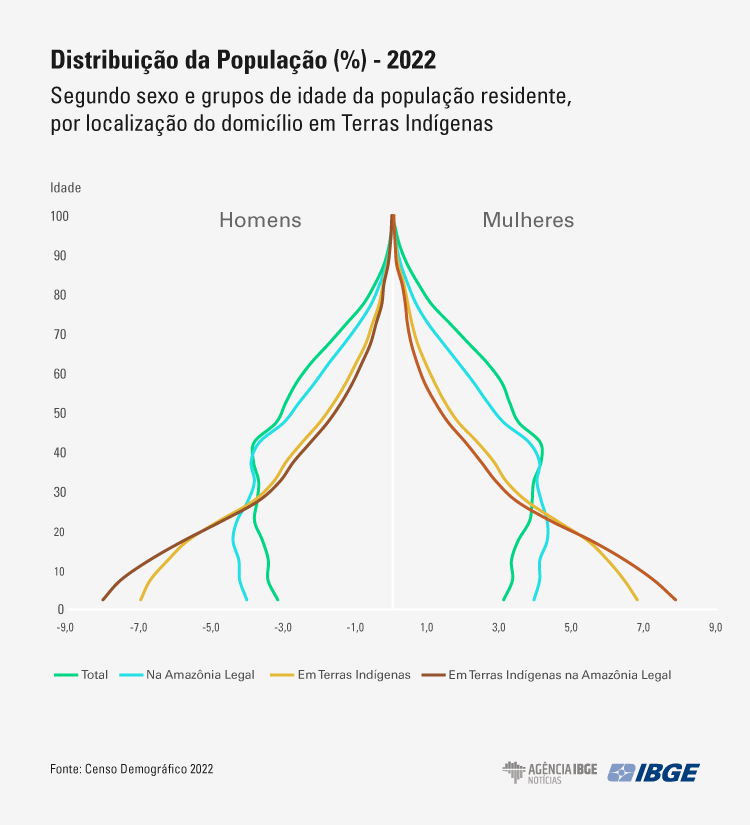
Quilombola Territories in the Legal Amazon: 96.90% of residents have poor access to water supply, sewage disposal or waste collection services
In officially delimited Quilombola Territories, 96.90% (88,870) of the residents faced some form of precariousness in water supply, sewage disposal and waste collection. When these three forms are considered simultaneously, the proportion was 36.55% (33,521). These percentages are above what was observed in the total Quilombola Territories in the country: 85.89%, for some form of precariousness, and 28.19%, for the three of them.
| Moradores em domicílios particulares permanentes ocupados, por forma principal de abastecimento de água e existência de canalização, destinação do esgoto e destinação do lixo, segundo localização domicílio nos Territórios Quilombolas, na Amazônia Legal e as Unidades da Federação – Brasil - 2022 | |||||
|---|---|---|---|---|---|
| Localização do domicílio | Moradores em domicílios particulares permanentes ocupados | ||||
| Total | Conviviam com alguma forma de precariedade em relação ao abastecimento de água, à destinação do esgoto ou à coleta de lixo (1) | Conjugavam formas de precariedade em relação ao abastecimento de água, à destinação do esgoto e à coleta de lixo (2) | |||
| Absoluto | Percentual (%) | Absoluto | Percentual (%) | ||
| Total | 202.083.020 | 55.135.092 | 27,28 | 6.053.981 | 3,00 |
| Em Territórios Quilombolas | 203.285 | 174.600 | 85,89 | 57.304 | 28,19 |
| Na Amazônia Legal | 26.532.205 | 15.301.927 | 57,67 | 2.317.711 | 8,74 |
| Em Territórios Quilombolas na Amazônia Legal | 91.710 | 88.870 | 96,90 | 33.521 | 36,55 |
| Amazônia Legal de Rondônia (RO) | 231 | 231 | 100,00 | 62 | 26,84 |
| Amazônia Legal do Acre (AC) | - | - | - | - | - |
| Amazônia Legal do Amazonas (AM) | 1.412 | 1.412 | 100,00 | 543 | 38,46 |
| Amazônia Legal de Roraima (RR) | - | - | - | - | - |
| Amazônia Legal do Pará (PA) | 48.462 | 47.303 | 97,61 | 18.629 | 38,44 |
| Amazônia Legal do Amapá (AP) | 6.769 | 5.384 | 79,54 | 605 | 8,94 |
| Amazônia Legal de Tocantins (TO) | 1.903 | 1.887 | 99,16 | 551 | 28,95 |
| Amazônia Legal do Maranhão (MA) | 31.780 | 31.521 | 99,19 | 13.073 | 41,14 |
| Amazônia Legal de Mato Grosso (MT) | 1.153 | 1.132 | 98,18 | 58 | 5,03 |
| Fonte: IBGE, Censo Demográfico 2022. (1) Rede geral de distribuição, poço, fonte, nascente ou mina encanada até o terreno ou não chega encanada, ou aqueles em que, com ou sem encanamento, a água utilizada é proveniente de carro-pipa, água da chuva armazenada, rios, açudes, córregos, lagos, igarapés ou de outras formas não listadas anteriormente; ou têm como destinação do esgoto fossa rudimentar, buraco, vala, rio, córrego, mar ou outra forma, ou sem esgotamento (devido à inexistência de banheiros ou sanitários); ou o lixo não é coletado direta ou indiretamente por serviço de limpeza. (2) Rede geral de distribuição, poço, fonte, nascente ou mina encanada até o terreno ou não chega encanada, e aqueles em que, com ou sem encanamento, a água utilizada é proveniente de carro-pipa, água da chuva armazenada, rios, açudes, córregos, lagos, igarapés ou de outras formas não listadas anteriormente; e têm como destinação do esgoto fossa rudimentar, buraco, vala, rio, córrego, mar ou outra forma, ou sem esgotamento (devido à inexistência de banheiros ou sanitários); e o lixo não é coletado direta ou indiretamente por serviço de limpeza. |
|||||
Officially delimited Quilombola Territories in the Legal Amazon had 91,784 residents in 2022, of which 88.51% (81,234) were Quilombolas and 11.49% (10,550), non-Quilombolas. In the country, 203,574 people lived in Quilombola territories.
Among the 427,801 Quilombolas living in the Legal Amazon, 18.89% (81,234) are in Quilombola Territories, whereas 81.01% (346,567), out of these areas. Among the states that compose the Legal Amazon, the proportion of Quilombolas in Quilombola Territories was: Amazonas (43.78%), Amapá (38.07%), Pará (32.86%), Maranhão (11.27%), Tocantins (10.16%), Mato Grosso (8.17%), Rondônia (7.56%). No Quilombolas were found in Acre and Roraima.
Of the 62,456 occupied permanent private housing units in Quilombola Territories, 41.63% (26,000) are in the Legal Amazon. The average of residents in these localities is 3.53, above that found in Quilombola Territories in the country, which is 3.25. Of the 203,285 residents of occupied permanent private housing units in Quilombola Territories in the country, 91,710 (45.11%) lived in the Legal Amazon.
Quilombola Territories in the Legal Amazon: illiteracy rate is 17.87%
Of the 65,081 persons aged 15 and over living in Quilombola Territories in the Legal Amazon, 82.13% (53,454) were literate and 17.87% (11,627), illiterate. The literacy rate of persons in these territories (82.13%) is very close to that observed in Quilombola Territories in Brazil (80.79%).
Amazonas (95.19%), Amapá (91.36%), Rondônia (86.71%), Pará (85.84%) and Mato Grosso (84.24%) had literacy rates in Quilombola Territories were above the average in Quilombola Territories in the Legal Amazon (82.13%). The lowest literacy rate was found in (74.70%).
The resident population presents a slightly higher share in Quilombola Territories in the Legal Amazon of persons between 35 and 39 years, with similarity between male and female age groups. The age Pyramid also shows a younger population in officially-delimited Quilombola Territories when compared to the age structure in the Legal Amazon.
